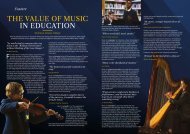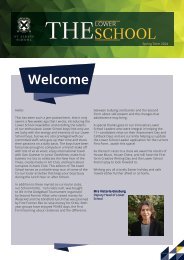Create successful ePaper yourself
Turn your PDF publications into a flip-book with our unique Google optimized e-Paper software.
88<br />
land rights was clear, with a treaty in New Zealand<br />
in 1840 being produced that recognised the<br />
native Maori land rights, but no similar provision<br />
was made for Aboriginal Australians. Despite the<br />
conflict, no state of war was declared. Actions by<br />
settlers in attacking these communities therefore<br />
entered into a legal grey area, as the Aboriginal<br />
Australians were technically subjects of British<br />
Empire which should have granted a degree of<br />
legal protection. In this scenario, if an Aboriginal<br />
Australian attacked a settler’s livestock, they might<br />
be expected to be put on trial in front of a court.<br />
However, no perpetrators of violence were brought<br />
to trial. Similarly, settlers were never punished for<br />
disproportionate reaction nor their appropriation<br />
of land. No significant efforts were made to slow<br />
the advance of settler communities into the interior.<br />
Therefore, violent clashes were guaranteed to<br />
continue. Only when new, more reliable weapons<br />
were used by settlers from about the 1850s were<br />
they able to set out and deal with whom they saw as<br />
troublesome.<br />
Aboriginal Australians were slowly pushed from<br />
areas with enough availability of resources, and<br />
being forced into areas inhabited by other groups,<br />
which produced even greater population pressures.<br />
As the last available land was quickly being settled,<br />
impoverishment and unsuitable life on the frontier<br />
left many with no choice but to live on the fringes<br />
of European settlements. The remainder, by law<br />
were forced into restricted reserves, like that in the<br />
state of Victoria in 1856. Many Europeans viewed<br />
the position they put these communities in to be<br />
a ‘cultural extinction’, with Aboriginal Australian<br />
populations falling dramatically. Those able to live<br />
near European settlements typically did so in slums.<br />
Any work that was available was poorly rewarded-<br />
some could offer their skills and knowledge of<br />
navigating the wilderness, but others were forced<br />
to scavenge and beg. Poverty, poor sanitation, poor<br />
health and their proximity to Europeans meant that<br />
a significant number died from Old World Diseases<br />
such as smallpox. The helpless state that Aboriginal<br />
Australians had been forced into was noticed<br />
by contemporaries and was in some spheres praised<br />
and in others condemned. One such is Secretary of<br />
State for the colonies, Sir George Murray’s letter to<br />
Governor Arthur of Tasmania, speaking of how:<br />
“The extinction of the Native race could not fail to leave<br />
an indelible stain upon the character of the British government”<br />
The <strong>Gateway</strong> <strong>Chronicle</strong><br />
Clearly, therefore, one can see the profound impact<br />
that British colonialism had on Aboriginal Australians.<br />
After having lived and adapted to the varied<br />
climates of Australia over thousands of years, many<br />
were left uprooted from their lives and forced to<br />
move over huge distances just to escape the advance<br />
of colonisation.<br />
Even today, Aboriginal Australians suffer with the<br />
effects of colonisation and settlement. Most did<br />
not have full citizenship and voting rights until<br />
1965, and only in 1967 was it voted that federal<br />
laws would also apply to them equally. From 1910<br />
to 1970 a policy of assimilation was pursued by the<br />
Australian government. This involved the forced<br />
removal of 10-33% of Aboriginal Australian children<br />
from their homes, to then be placed in adoptive<br />
families or institutions. When there, they were<br />
forbidden to speak their native languages and had<br />
their names changed, and abuse and neglect were<br />
common, all based on the false assumption that<br />
their lives would be improved if they became part<br />
of European society. The effects of this still leave<br />
scars upon the community- many forced into these<br />
families and institutions, as well as their own families<br />
and communities, suffer with higher rates of<br />
mental illnesses. Aboriginal Australians still suffer<br />
worse health and socioeconomic outcomes. Efforts<br />
have been made to heal these historic injustices,<br />
with Prime Minister Kevin Rudd issuing a national<br />
apology for the country’s actions towards these<br />
individuals in 2008, however there is much more<br />
to be done for these communities. Not only were<br />
many lives lost due to colonialism in Australia, but<br />
Aboriginal culture, language, even their knowledge<br />
of the land they lived in, that had developed over<br />
thousands of years were also lost. Historians can<br />
only hope to piece together a coherent picture of<br />
Aboriginal history from the evidence still available,<br />
but the loss of such a unique and long-lasting society<br />
presents not only a loss to Aboriginal Australian<br />
communities themselves, but a fatal detriment to<br />
humanity as a whole.<br />
Sam McDonald U6LAB


















